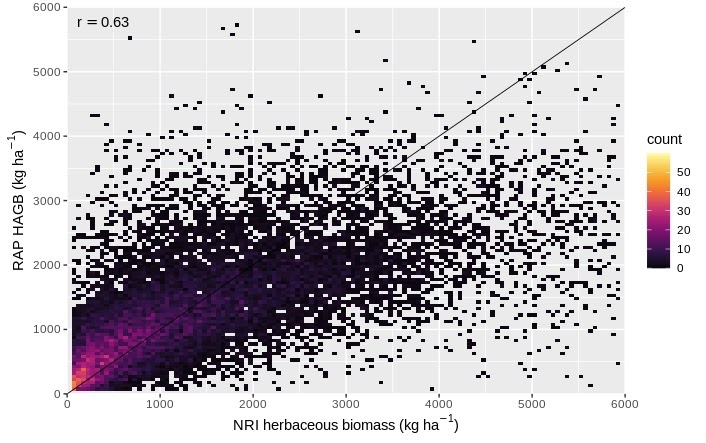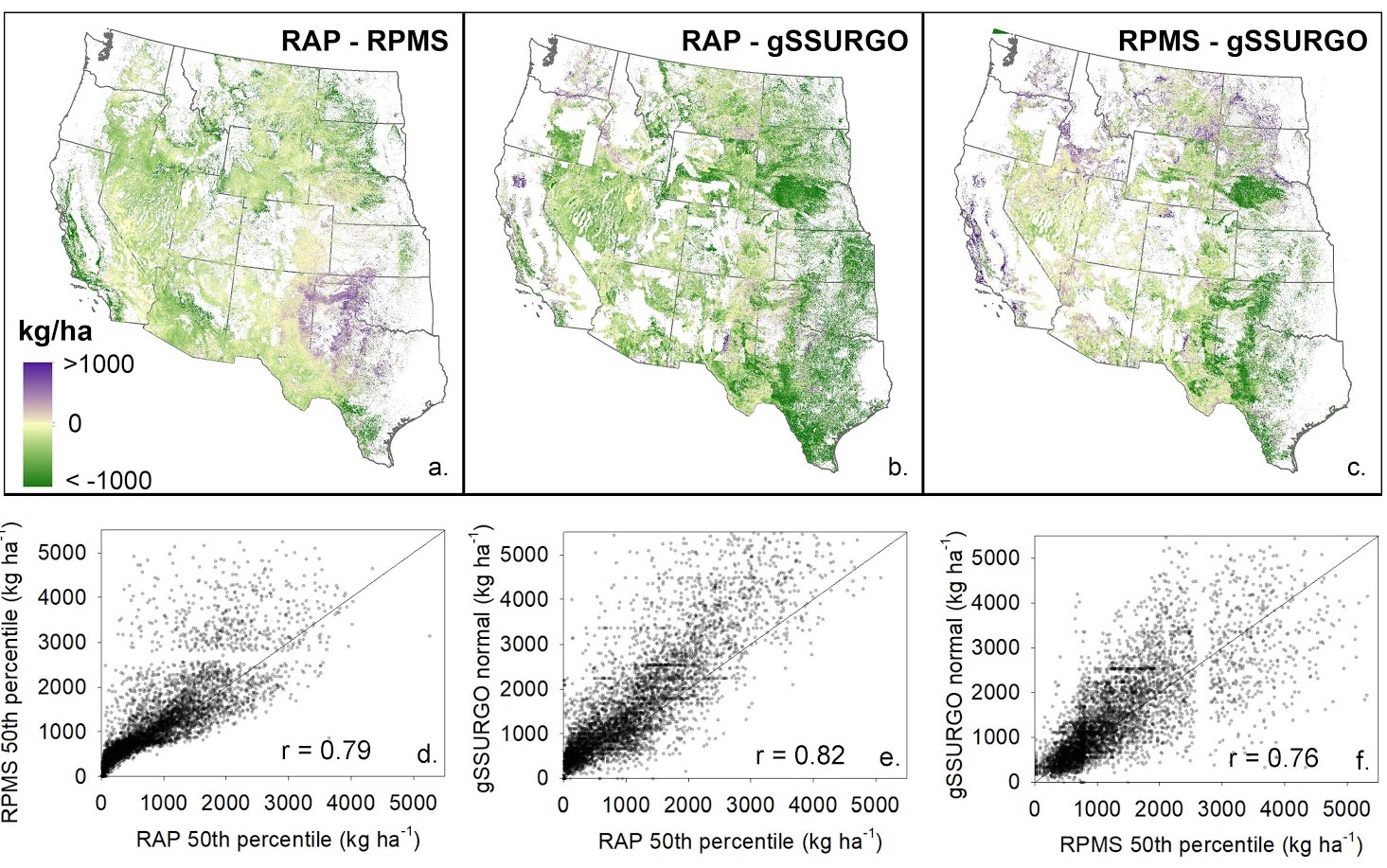Products
Biomass
The Rangeland Analysis Platform’s vegetation biomass product provides annual and 16-day aboveground biomass from 1986 to present of: annual forbs and grasses, perennial forbs and grasses, and herbaceous (combination of annual and perennial forbs and grasses). Estimates represent accumulated new biomass throughout the year or 16-day period and do not include biomass accumulation in previous years. Aboveground biomass was calculated by separating net primary production (paritioned by functional group) to aboveground and converting carbon to biomass (Jones et al. 2021, Robinson et al. 2019). Estimates are provided in United States customary units (lbs/acre) to facilitate use. Although these data were produced across a broad region, they are primarily intended for rangeland ecosystems. Biomass estimates may not be suitable in other ecosystems, e.g., forests., and are not to be used in agricultural lands, i.e., croplands.
16-day biomass estimates for the current year are provisional and will be recalculated at the end of the year. Significant land cover changes (e.g., woodland to grassland, shrubland to grassland) during the current year may or may not be reflected in the partitioning of biomass to functional groups. We urge users to critically inspect current year 16-day biomass estimates and interpret appropriately.
Biomass estimates are calculated using a process-based model and therefore traditional error metrics (e.g., MSE, RMSE) are not available. A comparison of biomass estimates to gSSURGO, the Rangeland Production Monitoring Service, and 16,591 USDA NRCS NRI on-the-ground estimates is reported in Jones et al. (2021).

Density scatterplot of RAP herbaceous aboveground biomass (HAGB) and 16,591 USDA
NRCS NRI plot-level biomass estimates, 1:1 line (black), and Pearson correlation
coefficient (r=0.63). Figure from Jones et al.
(2021).

Differences (a-c) between three gridded rangeland production datasets across
western U.S. rangelands using the 50th percentile of annual values (2000-2018)
from RAP and RPMS data, and ‘normal’ values from gSSURGO. Scatterplots and
Pearson correlation coefficients (d-f) of production values sampled from each
data set for 5000 randomly selected rangeland locations. Figure from Jones et
al. (2021).
The vegetation biomass data and maps are intended to be used alongside local knowledge and on-the-ground data to inform management actions that improve rangelands and wildlife habitat. They should not be used in isolation to quantify rangeland resources, determine or define thresholds, or evaluate the efficacy of management practices or treatments. Data can be used to evaluate resources in concert with site-specific information about the area under investigation, such as past land management practices, vegetation treatments, conservation efforts, or natural disturbances.
Jones, M.O., N.P. Robinson, D.E. Naugle, J.D. Maestas, M.C. Reeves, R.W. Lankston, and B.W. Allred. 2021. Annual and 16-day rangeland production estimates for the western United States. Rangeland Ecology & Management 77:112–117. http://dx.doi.org/10.1016/j.rama.2021.04.003
Robinson, N.P., M.O. Jones, A. Moreno, T.A. Erickson, D.E. Naugle, and B.W. Allred. 2019. Rangeland productivity partitioned to sub-pixel plant functional types. Remote Sensing 11:1427. https://dx.doi.org/10.3390/rs11121427
Cover
The Rangeland Analysis Platform’s vegetation cover product provides annual percent cover estimates from 1986 to present of: annual forbs and grasses, perennial forbs and grasses, shrubs, trees, and bare ground. The estimates were produced by combining 75,000 field plots collected by BLM, NPS, and NRCS with the historical Landsat satellite record. Utilizing the power of cloud computing, cover estimates are predicted across the United States at 30m resolution, an area slightly larger than a baseball diamond.
Vegetation cover estimates are model predictions. When interpreting cover, it is important to consider the model error specific to each functional group. Error metrics measure the average difference between predicted model output and separate on-the-ground measurements. For vegetation cover, 10% (approximately 7,500 plots) of the field plot data were withheld from model training and used for evaluation. The error metrics in the table below represent the average accuracy of the model for each functional group:
| Vegetation cover | Annual forbs and grasses | Perennial forbs and grasses | Shrubs | Trees | Bare ground |
|---|---|---|---|---|---|
| Mean absolute error (%) | 7.0 | 10.2 | 6.2 | 2.6 | 6.5 |
| Root mean square error (%) | 11.0 | 14.0 | 8.8 | 6.7 | 9.6 |
These errors provide a general accuracy assessment. For example, across 7,500 field plots, the average RAP prediction for annual forb and grass pixel was +/- 7.0% (mean absolute error) relative to field plot measurements.
The vegetation cover data and maps are intended to be used alongside local knowledge and on-the-ground data to inform management actions. They should not be used in isolation to quantify rangeland resources, determine or define cover thresholds, or evaluate the efficacy of management practices or treatments. Data can be used to evaluate resources in concert with site-specific information about the area under investigation, such as past land management practices, vegetation treatments, conservation efforts, or natural disturbances.
Allred, B.W., B.T. Bestelmeyer, C.S. Boyd, C. Brown, K.W. Davies, M.C. Duniway, L.M. Ellsworth, T.A. Erickson, S.D. Fuhlendorf, T.V. Griffiths, V. Jansen, M.O. Jones, J. Karl, A. Knight, J.D. Maestas, J.J. Maynard, S.E. McCord, D.E. Naugle, H.D. Starns, D. Twidwell, and D.R. Uden. 2021. Improving Landsat predictions of rangeland fractional cover with multitask learning and uncertainty. Methods in Ecology and Evolution. http://dx.doi.org/10.1111/2041-210x.13564
Data download
Annual biomass data are available in Google Earth Engine (derive from ImageCollections ‘projects/rap-data-365417/assets/npp-partitioned-v3’, ‘projects/rap-data-365417/assets/npp-partitioned-16day-v3’, and ‘projects/rap-data-365417/assets/npp-partitioned-16day-v3-provisional’ using a biomass conversion script; See example) and as GeoTIFFs from http://rangeland.ntsg.umt.edu/data/rap/rap-vegetation-biomass/.
Cover data are available in Google Earth Engine (ImageCollection ‘projects/rap-data-365417/assets/vegetation-cover-v3’) and as GeoTIFFs from http://rangeland.ntsg.umt.edu/data/rap/rap-vegetation-cover/.
Carbon
Partitioned NPP
The Rangeland Analysis Platform provides net primary productivity (NPP) estimates from 1986 to present. Estimates are partitioned into the following functional groups: annual forb and grass, perennial forb and grass, shrub, and tree. NPP is the net increase (i.e., photosynthesis minus respiration) in total plant carbon, including above and below ground.
Partitioned NPP cannot be viewed or analyzed in the RAP web application.
Robinson, N.P., M.O. Jones, A. Moreno, T.A. Erickson, D.E. Naugle, and B.W. Allred. 2019. Rangeland productivity partitioned to sub-pixel plant functional types. Remote Sensing 11:1427. https://dx.doi.org/10.3390/rs11121427
NPP data download
Partitioned NPP is available as GeoTIFFs from http://rangeland.ntsg.umt.edu/data/rap/rap-vegetation-npp/ and in Google Earth Engine (ImageCollections ‘projects/rap-data-365417/assets/npp-partitioned-v3’, ‘projects/rap-data-365417/assets/npp-partitioned-16day-v3’, and ‘projects/rap-data-365417/assets/npp-partitioned-16day-v3-provisional’).
Disclaimer
The Rangeland Analysis Platform is freely available for use by the public. The USDA Agricultural Research Service (ARS) and the U.S. Government have not placed any restriction on its use or reproduction of its contents. Although all reasonable efforts have been taken to ensure the accuracy and reliability of the s data, the ARS and the U.S. Government do not and cannot warrant the performance or results that may be obtained by their use. The ARS and the U.S. Government disclaim all warranties, expressed or implied, including warranties of performance, merchantability or fitness for any particular purpose.